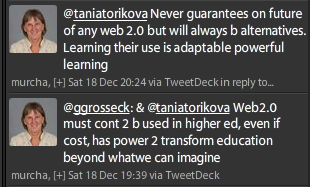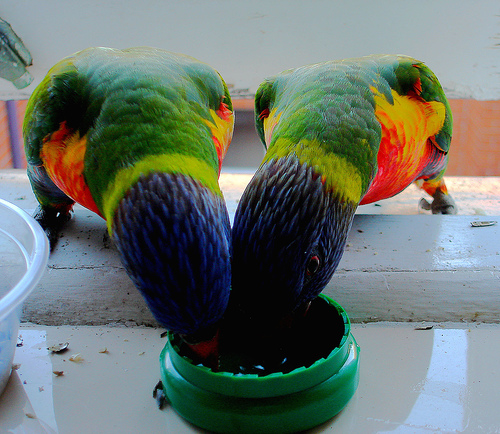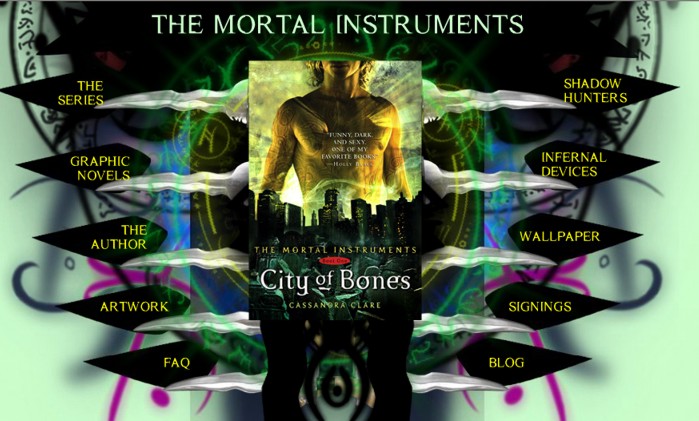[slideshare id=13433007&w=427&h=356&sc=no]
Tag Archives: del.icio.us
How Delicious it was
The words from Big yellow taxi come to mind
Don’t it always seem to go
That you don’t know what you’ve got
Till it’s gone
That’s how it’s suddenly hit me with the news about Yahoo terminating the popular social bookmarking site, Delicious. I haven’t felt this disappointed since Ning stopped free service. Delicious was one of the first Web 2.0 tools I used and raved about to other people. Not only an extremely efficient way to save links and render them searchable via tagging, but also a very transparent way to follow what other people are reading and saving.
I’m slow off the mark with this post; so many people have already tweeted and blogged their despair but it’s taking a while to settle in. At first I thought, oh well, I still have Diigo. And actually, I’ve been sending my links to Delicious via Diigo for some time since it’s so easy to use Diigo’s bookmarklet for recording essential information, and since, like others, I’ve used the automatic Diigo to Delicious function.
But then today I decided to have a look at my Delicious and realised how easy it is to see what people in your network are reading and saving. The beauty of Delicious is in the Network. Not only can I see what someone in my network is reading and saving, I can see an alphabetical listing of their tags, their tag bundles and their lists. This means I have an insight into the way their thinking, what’s important to them, the direction they’re taking.
And now I’m lamenting not using Delicious as well as I should have. Why didn’t I use tag bundles or make lists? Typical that I’d want to start now that Delicious is on its last legs.
Seriously, many people have written about the demise of Delicious with informative alternatives. I like Anne Mirtschin’s post. Anne’s not a whinger like me; she’s a postive, forward thinking person who remains open to future possibilities.
Just the other day, when Anne read on Twitter that @ggrosseck and I were wondering if we could trust cloud applications, if we should stop promoting Web 2.0 tools to colleagues, Anne responded with her characteristically unwavering conviction:
“Never any guarantee on the future of any Web 2.0 but will always be alternative”.
Wise words, Anne, very true.
Good luck, everyone, in exporting your Delicious bookmarks and finding alternatives.
ACEC2010 My slant
How is it that a conference about technology, namely the ACEC 2010, the national biennial conference of the Australian Council for Computers in Education, wasn’t chiefly about technology?
That’s a good thing in case you’re wondering.
So, for me, at least, the conference was about the opportunities to meet new people, share ideas and make connections. Some of these people I hadn’t previously met, others I knew online and was happy to finally meet face to face. And the program wasn’t too bad either.
I attended one day in body and the other days virtually. Either way, I was there thanks to the gracious collaboration of participants on Twitter #acec2010 and other great places to be when you’re not there.
The theme of the conference expresses the essence of the program:
Digital Diversity conference explores interactive and creative approaches to ICT in education. Addressing diversity in styles of learning and thinking offers us new pathways for building the right knowledge and skills to adapt to constant change.
Yes, the theme of the conference is ICT, but the words ‘interactive’, ‘creative’, ‘diversity’, thinking’, ‘building’ and ‘adapt to change’ express the real focus.
The sharing has been amazing. For example, @ackygirl tweeted a link to the Twitter transcript.
Here are ACEC2010 Delicious links.
Alan November‘s plenary and workshop sessions were a highlight for me on the Wednesday.
Amongst other things, Alan spoke about authentic learning projects based in the real world, for example, the teacher and students who built their own Wikipedia page. Listen to these students describe themselves as historians in the most serious way.
A huge thankyou to organisers of this very successful conference. Hope to see everyone again next year.
Have you learned to share?
Photo courtesy of Eliselovesprada on Flickr
Marie Salinger just shared with me an excellent blog post written by Andrew Douch, No learning for unauthorised persons. Andrew expresses his disappointment in the fact that many teachers are reluctant to share what they create for their students’ learning. I recommend that you read the entire post.
In my comment following Andrew’s post, I mention that my role as teacher librarian automatically puts me in the position of finding and sharing resources, and that I don’t see why I shouldn’t share outside my school, or even outside my country. Since forming a personal learning network on Twitter, Facebook, Delicious, Diigo and similar networking platforms, I’ve realised that what I share with others is a drop in the ocean compared with what I receive. If only all teachers would experience this.
My blogs and wikis are also a way of sharing ideas, resources and discussions which would otherwise only be shared with a couple of colleagues or not at all. It seems that blog authors find all manner of things useful and edifying, and write about these. I’ll often share resources this way, or even re-post from someone else’s blog if I think it’s worth passing on and giving my two cents worth.
More problematic is the sharing of material which I’ve read in a hard-copy publication. Currently, I’m reading the current edition of Fiction Focus: New titles for teenagers published by Curriculum Materials Information Services, WestOne Services, Department of Education and Training, Western Australia. It’s a teacher librarian’s treasured resource, providing excellent critical reviews of adolescent fiction, as well as reviews of resources of professional interest to teachers. I’m also reading the Centre for Youth Literature Newsletter published by the State Library of Victoria.
It’s frustrating for me to read these excellent resources and not share them online. What may normally occur is that we read them and take out ideas and resources for our own practice, or at best, email a few teachers if we think there is something of interest for them.
So what’s problematic? Well, it’s common practice to re-post online content written by someone else because you can give a synopsis and hyperlink to the actual resource; you don’t have to do more than give a quick summary of the original post since the reader can go directly to the source for more detailed information.
Not so in this instance. I would really like to feature some of the articles in these publications, but how much should I say? I don’t want to overload my readers, and I can’t presume they will obtain the hardcopy publications. I’m not sure if the publishers will consider my efforts a breach of copyright.
For example, there’s an excellent special feature in Fiction Focus, Wow websites – book inspired web wonders, which links to Young Adult fiction websites which
use high quality art and web design to create spaces and interfaces that reflect the character of the fiction that they represent,
providing
spaces for young readers to do what they have always done: play, discuss and imagine…
I applaud the promotion of such websites because I’ve realised that reading becomes an experience when adolescent readers become involved in the art, interactive activities and games, author blog and videos. Providing such websites increases the chances of hooking young people into reading fiction.
Here are the links to author websites provided by this article:
Angie Sage’s Septimus Heap series
Cassandra Clare’s Mortal Instruments series
Anthony Horowitz’s Alex Rider series
Charlie Higson’s Young Bond series
Robert Muchamore’s Cherub series
For Picture Book authors, there are links to the following websites:
Chris Priestley’s Tales of Terror Gothic feel site
Scott Westerfeld’s new Steampunk-inspired website
The selected works of T. S. Spivet by Reif Larsen
The CMIS Fiction Focus blog include more extensive links to more blogs and websites of young adult authors and illustrators.
Fiction Focus also has an excellent article on Steampunk,
a sub-genre of fantasy and speculative fiction. At the core of steampunk is the notion of altered history (often Victorian and London-Victorian at that) combined with technology that is historically impossible, and therefore all the more intriguing.
There are great links included, so you can see my dilemma – I’d like to share all these wonderful resources with people, but I really think they should subscribe to the magazine, or even, the magazine should go online. CMIS has also given us a taste of Steampunk in their blog which is worth adding to your RSS feed reader, but I can’t resist including all the Steampunk blog links given here as well.
Steampod (podcasts)
Antipodean Steampunk Adventures with an Australian slant
The Antipodean League of Temporal Voyagers
Do read the Fiction Focus blog post about Steampunk.
And guess what? From May 2010, the Centre for Youth Literature Newsletter will be going online. Yes!
Hating school, loving learning
Nevertheless, the point about disengagement of students is one with which most educators would not argue. Wesch entertains the idea of ‘play’ as opposed to dull routine and meaningless tasks.
Perhaps the word “play” is imperfect. I could say that in school, they should be invigorated or engaged or even inspired. But whatever the word, the idea is to create a stimulating environment were the learning comes natural and not forced, where the desire to learn is created first. Then, the labor of learning is a labor of love.
Technology is what students of today play with. As many advocators of 21st century learning suggest, technology plays a large part in the new vision of education. But technology is also the thorn in the side of a large number of teachers. Although we use the language – ‘integration of technology into learning’ – not many of us have actually taken this seriously. Managing technology in the classroom is often seen as asking for more problems. Wesch is clear about the role of technology in his classroom:
Texting, web-surfing, and iPods are just new versions of passing notes in class, reading novels under the desk, and surreptitiously listening to Walkmans. They are not the problem. They are just the new forms in which we see it. Fortunately, they allow us to see the problem in a new way, and more clearly than ever, if we are willing to pay attention to what they are really saying.
What are they saying? I think they’re saying that they’re bored, that their tasks are not relevant, that their projects are not engaging, that they’re sick of being passive recipients of content over which they have no control. When they turn to texting or web-surfing, they’re getting out of the classroom, they’re reaching out into the world.
Wesch explains this problem:
And that’s what has been wrong all along. Some time ago we started taking our walls too seriously – not just the walls of our classrooms, but also the metaphorical walls that we have constructed around our “subjects,” “disciplines,” and “courses.”
When I was in primary school, I had a strong sense of where I belonged. I belonged only with kids who were born within 12 months of my birthday. I was afraid of those a year ahead of me who belonged to an entirely differentand superior group, one that I wasn’t to have anything to do with. If I had known what learning took place in the older years, I would have wanted to be there, but I learned to sit and wait during reading classes, as students took turns to labour over stories in our reader, stories I had already read early in the year. There was no wider reading, there was no skipping ahead, we all had to be open to the same page, doing nothing but daydreaming. The reader was all we had for the entire year. And so would the next class the following year. Of course, now things have changed a great deal. Now we have many more reading choices, and in some cases primary students can choose to read library books instead of readers from the box.
But I’m not sure that things have changed as much as we think. We still teach from textbooks. We’re not all consistently planning scaffolded inquiry-based projects which ask rich questions. We’re not experimenting enough ourselves with technological applications and seeing educational possibilities. We’re still proud of research assignments that supposedly encourage independent learning, assignments which leave our students to google incompetently, to copy and paste, to present superficial findings, to lose interest, to just get the thing done, hand it in and sigh with relief.
Wesch is clear about the solution:
Fortunately, the solution is simple. We don’t have to tear the walls down. We just have to stop pretending that the walls separate us from the world, and begin working with students in the pursuit of answers to real and relevant questions.
He says we need to acknowledge the shift in learning based on information being everywhere. What we should do is let go of ‘the sage on the stage’.
When we do that we can stop denying the fact that we are enveloped in a cloud of ubiquitous digital information where the nature and dynamics of knowledge have shifted. In the process, we allow students to develop much-needed skills in navigating and harnessing this new media environment, including the wisdom to know when to turn it off. When students are engaged in projects that are meaningful and important to them, and that make them feel meaningful and important, they will enthusiastically turn off their cellphones and laptops to grapple with the most difficult texts and take on the most rigorous tasks.
Something is not right in the state of education. Wesch, to finish off:
And there’s the rub. We love learning. We hate school. What’s worse is that many of us hate school because we love learning.
It doesn’t have to be this way…
#16 Taste test
Originally uploaded by Liquang
It’s a bit like piggybacking. Del.icio.us, that is. I jump on the back of a person I revere, a person whose blogs, wikis, professional guidance I’ve been following, and suddenly I’ve hit the jackpot! Somehow I’ve managed to legally ‘steal’ someone else’s hard work, time and mental journeys. Of course, I also develop my own social bookmarking links on Del.icio.us. It’s all fair. Although I have to warn those who think my Del.icio.us links are worth ‘stealing’ that my path to bookmarking is slightly crooked, and that they’ll be plunged into a randomness that only I can decifer.Tagging is magical. As far as I’m concerned, it’s like waving a magic wand. It has freed the outdated subject heading, that hallowed entity that demands strict adherence to its unflinching laws. I started using Furl before I tried Del.icio.us, but it doesn’t bring up previously generated tags for you to grab like Del.icio.us does. Like many new Web 2.0 applications, Del.icio.us can be pulled out of the hat of any computer; the memory stick is redundant (no viruses!)One more thing, before you fall asleep – if you customise the del.icio.us URL, eg. http://del.icio.us/tag/wiki, you’ll get a combined view of the most recent links tagged with the last word, in this case, “wiki”. I think I’ll play around with that for a while…




